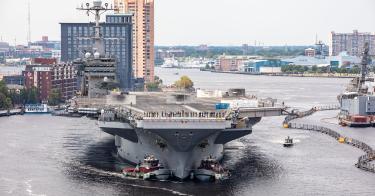President Joe Biden unveiled a bountiful $2 trillion infrastructure plan at his 100 Days address to Congress—with seemingly something for everybody, from electric vehicles to elder care. But for the sake of our national defense, there is one area of actual infrastructure which warrants attention now: U.S. Navy shipyards.
If we are going to make an investment in America, the four government-owned, government-operated Navy shipyards are great candidates for infrastructure spending.
First, they are vitally important to the national defense. These four yards maintain the Navy’s entire nuclear-powered fleet, which includes aircraft carriers, attack submarines, and ballistic missile submarines.
Secondly, the shipyards desperately need the investment: all four yards are over 100 years old, and their facilities were gradually built during very different eras of shipbuilding. Today, these facilities struggle with a workload beyond capacity for nuclear maintenance, creating big problems—and big delays—for aircraft carriers and a growing submarine fleet.
>>> 9 Things You Need to Know About Biden’s “Infrastructure” Spending Plan
The Navy already knows exactly how to bring its shipyards into the 21st century. The Shipyard Infrastructure Optimization Plan, the SIOP, is a state-of-the-art plan for a total re-engineering of each Navy shipyard using digital modeling. But because the Navy is strapped for funds, the available funding that the Navy can apply to this plan will not be enough, given the need to grow the fleet to keep pace with the Chinese and Russian fleets.
The Navy submitted the SIOP to Congress back in 2018 and has been pursuing it since. But two issues remain—both of which should be addressed through legislation.
The first is that the SIOP is a 20-year plan that depends on just-in-time funding, through annual defense appropriations, for a long series of projects. If funding for one dry-dock reconstruction project is delayed in a fiscal year (for example), the effects would ripple effect across the entire plan, as well as the entire maintenance schedule, for the nuclear-powered fleet.
Other funding solutions could resolve this problem and give the Navy guaranteed, consistent funding to complete the plan. One bipartisan proposal by Sens. Roger Wicker, Tim Kaine, Susan Collins, Angus King and Jeanne Shaheen (with companion legislation in the House by Reps. Rob Wittman and Mike Gallagher) would use the Defense Production Act to fund the entire SIOP with a one-time, $21 billion payment to the Navy. Such a move would provide the Navy access to consistent funding it needs to ensure it can bring its shipyards up to date.
The second concern with the SIOP is its scope. The plan addresses problems at the current shipyards, to meet the needs of the current fleet, but not the future fleet. Most experts believe the fleet must grow and change to meet 21st century needs. The Navy’s latest 30-year shipbuilding plan also include novel new unmanned platforms with evolving maintenance and sustainment requirements to consider, too.
Additionally, to execute the SIOP at the existing yards, some degree of maintenance disruption will take place as new facilities are built to replace outdated ones and dry docks are expanded. As such, the Navy will need excess maintenance capacity now for its submarines and aircraft carriers, and for a larger fleet in coming years.
Bottom line: The fleet needs more shipyard capacity both in commercial and the public shipyards to ensure a ready fleet today and into the future. Efforts to address this shortfall should be supported, especially given the fact that the decommissioning of the USS Bonhomme Richard after a severe fire last summer was due to an inability to effect repairs of the ship without jeopardizing critical maintenance or new construction.
The Navy had eight shipyards as recently as 1996 for a fleet of 359 ships (103 of them nuclear powered), and decisions to close those facilities were meant to realize a post-Cold War peace dividend. Now the U.S.’s geopolitical outlook has changed, and the calculus for proper amounts of ship maintenance capacity should change in kind.
>>> U.S. Navy Shipyards Desperately Need Revitalization and a Rethink
A new Navy shipyard, perhaps on the West Coast, would be particularly important to timely maintenance for top priority Pacific operations. And of course, needed new entrants into the maritime sector who can grow ship-building and sustainment capacity, while spurring innovation as the Navy grows its fleet and fields a new armada that can capture the imagination of a future generation of naval architects, shipyard workers, and sailors.
While the debate on our nation’s infrastructure heats up, it would be a mistake not to consider the Navy’s and the nation’s maritime industry as strategic infrastructure. Efforts to reverse the slow erosion of the nation’s shipyards are a welcome change to decades of divesture of naval infrastructure.
By funding the SIOP and building new shipyard capacity, Congress and the Biden administration have the opportunity to reverse a decades-long disinvestment and atrophying of naval infrastructure—and use this spending to fulfill a constitutional duty to provide and maintain the nation’s Navy.
This piece originally appeared in ArcaMax





